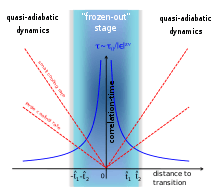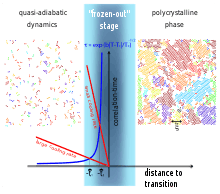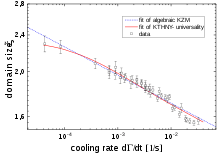Kibble–Zurek mechanism
The Kibble–Zurek mechanism (KZM) describes the non-equilibrium dynamics and the formation of topological defects in a system which is driven through a continuous phase transition at finite rate. It is named after Tom W. B. Kibble, who pioneered the study of domain structure formation in the early universe, and Wojciech H. Zurek, who related the number of defects it creates to the critical exponents of the transition and to its rate—to how quickly the critical point is traversed.
Basic idea
Based on the formalism of spontaneous symmetry breaking, Tom Kibble developed the idea for the primordial fluctuations of a two-component scalar field like the Higgs field.[1][2] If a two-component scalar field switches from the isotropic and homogeneous high-temperature phase to the symmetry-broken stage during cooling and expansion of the very early universe (shortly after Big Bang), the order parameter cannot be necessarily the same in regions which are not connected by causality. Regions are not connected by causality if they are separated far enough (at the given age of the universe) that they cannot "communicate" even with the speed of light. This implies that the symmetry cannot be broken globally. The order parameter will take different values in causally disconnected regions and the domains will be separated by domain walls after further evolution of the universe. Depending on the symmetry of the system and the symmetry of the order parameter, different types of topological defects like monopoles, vortices or textures can arise. It was debated for quite a while if magnetic monopoles might be residuals of defects in the symmetry-broken Higgs field.[3] Up to now, defects like this have not been observed within the event horizon of the visible universe. This is one of the main reasons (beside the isotropy of the cosmic background radiation and the flatness of spacetime) why nowadays an inflationary expansion of the universe is postulated. During the exponentially fast expansion within the first 10−30 second after Big-Bang, all possible defects were diluted so strongly that they lie beyond the event horizon. Today, the two-component primordial scalar field is usually named inflaton.
Relevance in condensed matter

Wojciech Zurek pointed out, that the same ideas play a role for the phase transition of normal fluid helium to superfluid helium.[4][5][6] The analogy between the Higgs field and superfluid helium is given by the two-component order parameter; superfluid helium is described via a macroscopic quantum mechanical wave function with global phase. In helium, two components of the order parameter are magnitude and phase (or real and imaginary part) of the complex wave function. Defects in superfluid helium are given by vortex lines, where the coherent macroscopic wave function disappears within the core. Those lines are high-symmetry residuals within the symmetry broken phase.
It is characteristic for a continuous phase transition that the energy difference between ordered and disordered phase disappears at the transition point. This implies that fluctuations between both phases will become arbitrarily large. Not only the spatial correlation lengths diverge for those critical phenomena, but fluctuations between both phases also become arbitrarily slow in time, described by the divergence of the relaxation time. If a system is cooled at any non-zero rate (e.g. linearly) through a continuous phase transition, the time to reach the transition will eventually become shorter than the correlation time of the critical fluctuations. At this time, the fluctuations are too slow to follow the cooling rate; the system has fallen out of equilibrium and ceases to be adiabatic. A "fingerprint" of critical fluctuations is taken at this fall-out time and the longest-length scale of the domain size is frozen out. The further evolution of the system is now determined by this length scale. For very fast cooling rates, the system will fall out of equilibrium very early and far away from the transition. The domain size will be small. For very slow rates, the system will fall out of equilibrium in the vicinity of the transition when the length scale of critical fluctuations will be large, thus the domain size will be large, too.[footnote 1] The inverse of this length scale can be used as an estimate of the density of topological defects, and it obeys a power law in the quench rate. This prediction is universal, and the power exponent is given in terms of the critical exponents of the transition.
Derivation of the defect density


Consider a system that undergoes a continuous phase transition at the critical value of a control parameter. The theory of critical phenomena states that, as the control parameter is tuned closer and closer to its critical value, the correlation length and the relaxation time of the system tend to diverge algebraically with the critical exponent as
respectively. is the dynamic exponent which relates spatial with temporal critical fluctuations. The Kibble–Zurek mechanism describes the nonadiabatic dynamics resulting from driving a high-symmetry phase to a broken-symmetry phase at . If the control parameter varies linearly in time, , equating the time to the critical point to the relaxation time, we obtain the freeze out time ,
This time scale is often referred to as the freeze-out time. It is the intersection point of the blue and the red curve in the figure. The distance to the transition is on one hand side the time to reach the transition as function of cooling rate (red curve) and for linear cooling rates at the same time the difference of the control parameter to the critical point (blue curve). As the system approaches the critical point, it freezes as a result of the critical slowing down and falls out of equilibrium. Adiabaticity is lost around . Adiabaticity is restored in the broken-symmetry phase after . The correlation length at this time provides a length scale for coherent domains,
The size of the domains in the broken-symmetry phase is set by . The density of defects immediately follows if is the dimension of the system, using
Experimental tests
The Kibble–Zurek mechanism generally applies to spontaneous symmetry breaking scenarios where a global symmetry is broken. For gauge symmetries defect formation can arise through the Kibble–Zurek mechanism and the flux trapping mechanism proposed by Hindmarsh and Rajantie.[7][8] In 2005, it was shown that KZM describes as well the dynamics through a quantum phase transition.[9][10][11][12]
The mechanism also applies in the presence of inhomogeneities,[13] ubiquitous in condensed matter experiments, to both classical,[14][15][16] quantum phase transitions[17][18] and even in optics.[19] A variety of experiments have been reported that can be described by the Kibble–Zurek mechanism.[20] A review by T. Kibble discusses the significance and limitations of various experiments (until 2007).[21]
Example in two dimensions
A system, where structure formation can be visualized directly is given by a colloidal mono-layer which forms a hexagonal crystal in two dimensions. The phase transition is described by the so called Kosterlitz–Thouless–Halperin–Nelson–Young theory where translational and orientational symmetry are broken by two Kosterlitz–Thouless transitions. The corresponding topological defects are dislocations and disclinations in two dimensions. The latter are nothing else but the monopoles of the high-symmetry phase within the six-fold director field of crystal axes. A special feature of Kosterlitz–Thouless transitions is the exponential divergence of correlation times and length (instead of algebraic ones). This serves a transcendental equation which can be solved numerically. The figure shows a comparison of the Kibble–Zurek scaling with algebraic and exponential divergences. The data illustrate, that the Kibble–Zurek mechanism also works for transitions of the Kosterlitz–Thoules universality class.[22]
Footnote
- In condensed matter, the maximal signal velocity is not given by the speed of light but by the sound velocity (or second sound in case of superfluid helium).
References
- Kibble, T. W. B. (1976). "Topology of cosmic domains and strings". J. Phys. A: Math. Gen. 9 (8): 1387–1398. Bibcode:1976JPhA....9.1387K. doi:10.1088/0305-4470/9/8/029.
- Kibble, T. W. B. (1980). "Some implications of a cosmological phase transition". Phys. Rep. 67 (1): 183–199. Bibcode:1980PhR....67..183K. doi:10.1016/0370-1573(80)90091-5.
- Guth, A.H. (1981). "Inflationary universe: A possible solution to the horizon and flatness problems". Phys. Rev. D. 23 (2): 347–356. Bibcode:1981PhRvD..23..347G. doi:10.1103/PhysRevD.23.347.
- Zurek, W. H. (1985). "Cosmological experiments in superfluid helium?". Nature. 317 (6037): 505–508. Bibcode:1985Natur.317..505Z. doi:10.1038/317505a0.
- Zurek, W. H. (1993). "Cosmic Strings in Laboratory Superfluids and the Topological Remnants of Other Phase Transitions". Acta Phys. Pol. B. 24: 1301.
- Zurek, W. H. (1996). "Cosmological experiments in condensed matter systems". Phys. Rep. 276 (4): 177–221. arXiv:cond-mat/9607135. Bibcode:1996PhR...276..177Z. CiteSeerX 10.1.1.242.1418. doi:10.1016/S0370-1573(96)00009-9.
- Hindmarsh, M.; Rajantie, A. (2000). "Defect Formation and Local Gauge Invariance". Phys. Rev. Lett. 85 (22): 4660–3. arXiv:cond-mat/0007361. Bibcode:2000PhRvL..85.4660H. doi:10.1103/PhysRevLett.85.4660. PMID 11082621.
- Rajantie, A. (2002). "Formation of topological defects in gauge field theories". Int. J. Mod. Phys. A. 17 (1): 1–43. arXiv:hep-ph/0108159. Bibcode:2002IJMPA..17....1R. doi:10.1142/S0217751X02005426.
- Damski, B. (2005). "The Simplest Quantum Model Supporting the Kibble-Zurek Mechanism of Topological Defect Production: Landau-Zener Transitions from a New Perspective". Phys. Rev. Lett. 95 (3): 035701. arXiv:cond-mat/0411004. Bibcode:2005PhRvL..95c5701D. doi:10.1103/PhysRevLett.95.035701. PMID 16090756.
- Zurek, W. H.; Dorner, U.; Zoller, P. (2005). "Dynamics of a Quantum Phase Transition". Phys. Rev. Lett. 95 (10): 105701. arXiv:cond-mat/0503511. Bibcode:2005PhRvL..95j5701Z. doi:10.1103/PhysRevLett.95.105701. PMID 16196941.
- Dziarmaga, J. (2005). "Dynamics of a Quantum Phase Transition: Exact Solution of the Quantum Ising Model". Phys. Rev. Lett. 95 (24): 245701. arXiv:cond-mat/0509490. Bibcode:2005PhRvL..95x5701D. doi:10.1103/PhysRevLett.95.245701. PMID 16384394.
- Polkovnikov, A. (2005). "Universal adiabatic dynamics in the vicinity of a quantum critical point". Phys. Rev. B. 72 (16): 161201(R). arXiv:cond-mat/0312144. Bibcode:2005PhRvB..72p1201P. doi:10.1103/PhysRevB.72.161201.
- del Campo, A.; Kibble, T. W. B.; Zurek, W. H. (2013). "Causality and non-equilibrium second-order phase transitions in inhomogeneous systems". J. Phys.: Condens. Matter. 25 (40): 404210. arXiv:1302.3648. Bibcode:2013JPCM...25N4210D. doi:10.1088/0953-8984/25/40/404210. PMID 24025443.
- Kibble, T. W. B.; Volovik, G. E. (1997). "On Phase Ordering Behind the Propagating Front of a Second-Order Transition". JETP Lett. 65 (1): 102. arXiv:cond-mat/9612075. Bibcode:1997JETPL..65..102K. doi:10.1134/1.567332.
- Zurek, W. H. (2009). "Causality in Condensates: Gray Solitons as Relics of BEC Formation". Phys. Rev. Lett. 102 (10): 105702. arXiv:0902.3980. Bibcode:2009PhRvL.102j5702Z. doi:10.1103/PhysRevLett.102.105702. PMID 19392126.
- del Campo, A.; De Chiara, G.; Morigi, G.; Plenio, M. B.; Retzker, A. (2010). "Structural Defects in Ion Chains by Quenching the External Potential: The Inhomogeneous Kibble-Zurek Mechanism". Phys. Rev. Lett. 105 (7): 075701. arXiv:1002.2524. Bibcode:2010PhRvL.105g5701D. doi:10.1103/PhysRevLett.105.075701. PMID 20868058.
- Zurek, W. H.; Dorner, U. (2008). "Phase transition in space: how far does a symmetry bend before it breaks?". Phil. Trans. R. Soc. A. 366 (1877): 2953–72. arXiv:0807.3516. Bibcode:2008RSPTA.366.2953Z. doi:10.1098/rsta.2008.0069. PMID 18534945.
- Dziarmaga, J.; Rams, M. M. (2010). "Dynamics of an inhomogeneous quantum phase transition". New J. Phys. 12 (5): 055007. arXiv:0904.0115. Bibcode:2010NJPh...12e5007D. doi:10.1088/1367-2630/12/5/055007.
- Pal, V.; et al. (2017). "Observing Dissipative Topological Defects with Coupled Lasers". Phys. Rev. Lett. 119 (1): 013902. arXiv:1611.01622. Bibcode:2017PhRvL.119a3902P. doi:10.1103/PhysRevLett.119.013902. PMID 28731766.
- del Campo, A.; Zurek, W. H. (2014). "Universality of phase transition dynamics: topological defects from symmetry breaking". Int. J. Mod. Phys. A. 29 (8): 1430018. arXiv:1310.1600. Bibcode:2014IJMPA..2930018D. doi:10.1142/S0217751X1430018X.
- Kibble, T.B.W. (2007). "Phase-transition dynamics in the lab and the universe". Physics Today. 60 (9): 47–52. Bibcode:2007PhT....60i..47K. doi:10.1063/1.2784684.
- Deutschländer, S.; Dillmann, P.; Maret, G.; Keim, P. (2015). "Kibble–Zurek mechanism in colloidal monolayers". Proc. Natl. Acad. Sci. USA. 112 (22): 6925–6930. arXiv:1503.08698. Bibcode:2015PNAS..112.6925D. doi:10.1073/pnas.1500763112. PMC 4460445. PMID 25902492.